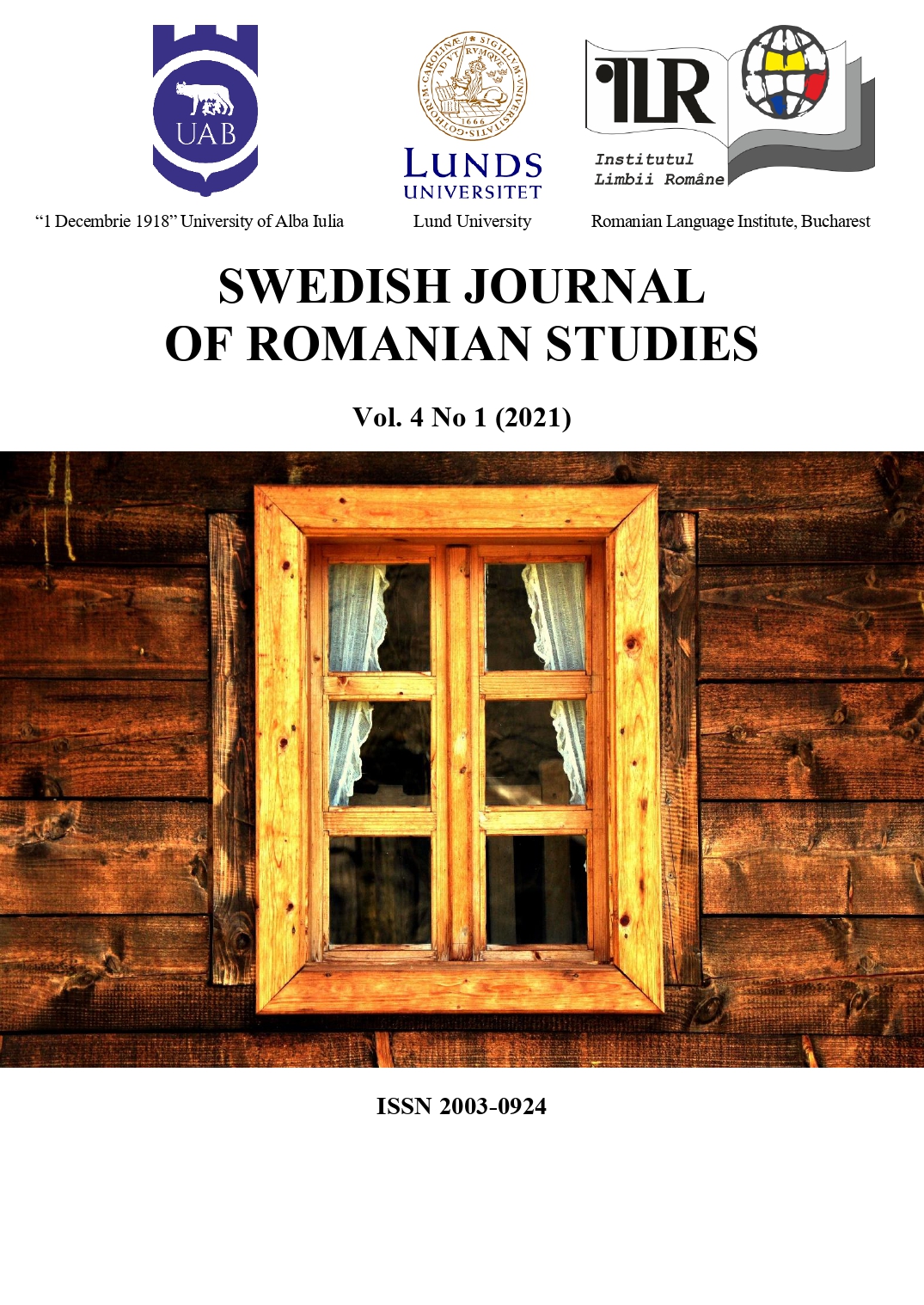A Romanian 19th century document from the Vidin region
DOI:
https://doi.org/10.35824/sjrs.v4i1.22480Nyckelord:
Romanian language, Bulgaria, Cyrillic script, Ottoman empire, 19th century, personal archivesAbstract
By bringing to the readers’ attention an unpublished Ottoman era document in Romanian, issued in 1861 in Rabrovo, a village in the Vidin region, back then under Ottoman rule, the article tries to shed light on the wider historical and sociolinguistic context of the Romanian-speaking population south of the Danube in the 19th century. The document is a donation-adoption act by which a Romanian man gives one of his sons for adoption to his brother, who does not have heirs. The document is handwritten in Romanian, using Cyrillic script, signed by the chorbaji, mayor and eight witnesses, and stamped by the Turkish administrator. Though very short, it reveals several important facts about the Romanian-speaking population in Ottoman Bulgaria and its origin, the language used in communication and writing, family relations, etc. Coming from a family archive, this document of great emotional value for its owner, has also undisputable linguistic and historical significance.
Referenser
Bucuța, E. (1923). Românii dintre Vidin și Timoc. Cu un adaus de documente, folklor, glosar, fotografii, hărți/ The Romanians between Vidin and Timok. With an appendix of documents, folklore, glossary, photographs, maps. București: Tipografia „Cartea Românească”.
Budiș, M. (2001). Comunitatea românească de pe valea Timocului bulgăresc/ The Romanian community on the Bulgarian Timok Valley. București: Editura Militară.
Djordjević, T. (1906). Kroz naše Rumune. Putopisne beleške/ Through our Romanians. Travel notes. In Srpski kniževni glasnik (Cyrillic).
Georgevitch, T.R. (1919). The Truth Concerning the Rumanes in Serbia. Paris: Imprimerie «Graphique».
Howard, D. (2017). A History of the Ottoman Empire. Cambridge: University Press. https://doi.org/10.1017/9781139026062
Huțanu, M. & Sorescu-Marinković, A. (2015). Graiul vlah în școlile din Serbia răsăriteană: provocări și perspective/ The Vlach variety in the schools of Eastern Serbia: challenges and perspectives. In Philologica Jassyensia, XI/2(22). 201-211.
Măran, M. (2012). Misionarul greco-catolic Simion (Samoil) Draxin și familia sa din Petrovasâla/ The Greek-Catholic missionary Simion (Samoil) Draxin and his family in Vladimirovac. In Anuar 2012. Zrenjanin: Editura ICRV. 125-133.
Mărgărit, I. & Neagoe, V. (1997). Cercetări asupra graiurilor românești vorbite în nord-vestul Bulgariei (regiunea Loveci)/ Research on the Romanian varieties spoken in North-West Bulgaria (Lovech region). In Fonetică și dialectologie, XVI. 75-96.
Neagoe, V. & Mărgărit, I. (2006). Graiurile dacoromâne din nordul Bulgariei. Studiu lingvistic. Texte dialectale/ Dacoromanian varieties of North Bulgaria. Linguistic study. Dialectal texts. București: Editura Academiei.
Nedelcu, G. (1993/1933). Puterea părintească în vechiul drept românesc/ Parental power in the old Romanian law. Ploiești: Editura Institutul Grafic „Miricescu”.
Nestorescu, V. (1996). Românii timoceni din Bulgaria – Grai. Folclor. Etnografie./ The Timok Romanians in Bulgaria – Language. Folklore. Ethnography. București: Editura Fundației Culturale Române.
Sorescu-Marinković, A. (2012). Românii din Timoc astăzi. Ființe mitologice/ The Vlachs of Eastern Serbia today. Mythological beings. Cluj-Napoca: Argonaut.
Țîrcomnicu, E. (2010). Românii din nordul Bulgariei – considerente istorice, sociologice și etnografice/ The Romanians in North Bulgaria – historical, sociological and ethnographical issues. In Philologica Jassyensia, VI/2(12). 255-265.
Țîrcomnicu, E. (coord.). (2011a). Atlasul etnografic român. Sărbători și obiceiuri. Românii din Bulgaria/ The Romanian Ethnographic Atlas. Holidays and customs. The Romanians in Bulgaria. Vol. I, Timoc/ Timok. București: Monitorul Oficial R.A.
Țîrcomnicu, E. (coord.). (2011b). Sărbători și obiceiuri. Românii din Bulgaria/ Holidays and customs. The Romanians in Bulgaria. Vol. II, Valea Dunării/ The Danube Valley. București: Editura Etnologică.
Vâlsan, G. (2001/1913). Studii antropogeografice, etnografice și geopolitice/ Anthropo-geographic, ethnographic and geopolitical studies. Cluj-Napoca: Editura Fundației pentru Studii Europene.
Weigand, G. (1900). Die rumänischen Dialekte der kleinen Walachei, Serbiens und Bulgariens/ The Romanian dialects of Little Wallachia, Serbia and Bulgaria. In Siebenter Jahresbericht des Instituts für Rumänische Sprache zu Leipzig/ Seventh annual report of the Institute for Romanian Language in Leipzig, 1-92. https://archive.org/stream/jahresberichtde02publgoog#page/n15/mode/2up. Accessed January 15, 2021.
Weigand, G. (1908). Rumänen und Aromunen in Bulgarien/ The Romanians and Aromanians in Bulgaria. Dreizehnter Jahresbericht des Instituts für Rumänische Sprache zu Leipzig/ Thirteenth annual report of the Institute for Romanian Language in Leipzig. 1-104. https://archive.org/details/jahresberichtde06publgoog/page/n53/mode/2up?q=31. Accessed January 29, 2021.
Internet resources
NSIB: National Statistical Institute of the Republic of Bulgaria, National Register of Populated Places. https://www.nsi.bg/nrnm/show9.php?sid=3904&ezik=en. Accessed February 23, 2021.
Downloads
Publicerad
Referera så här
Nummer
Sektion
Licens
Copyright (c) 2021 Annemarie Sorescu-Marinković

Detta verk är licensierat under en Creative Commons Erkännande-IckeKommersiell 4.0 Internationell-licens.
Authors who publish with this journal agree to the following terms:
a. Authors retain copyright and grant the journal right of first publication with the work simultaneously licensed under a Creative Commons Attribution-NonCommercial 4.0 International License that allows others to share the work with an acknowledgement of the work's authorship and initial publication in this journal.
b. Authors are able to enter into separate, additional contractual arrangements for the non-exclusive distribution of the journal's published version of the work (e.g., post it to an institutional repository or publish it in a book), with an acknowledgement of its initial publication in this journal.
c. Authors are permitted and encouraged to post their work online (e.g., in institutional repositories or on their website) prior to and during the submission process, as it can lead to productive exchanges, as well as earlier and greater citation of published work (See The Effect of Open Access).

